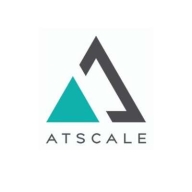

| Product | Market Share (%) |
|---|---|
| AtScale Adaptive Analytics (A3) | 5.5% |
| Denodo | 23.7% |
| TIBCO Data Virtualization | 18.2% |
| Other | 52.6% |
| Product | Market Share (%) |
|---|---|
| Dremio | 2.6% |
| Databricks | 10.7% |
| KNIME Business Hub | 10.1% |
| Other | 76.6% |

| Company Size | Count |
|---|---|
| Small Business | 1 |
| Midsize Enterprise | 5 |
| Large Enterprise | 5 |
AtScale is the leading provider of intelligent data virtualization for big data analytical workloads, empowering citizen data scientists to accelerate and scale their business’ data analytics and science capabilities and ultimately build insight-driven
AtScale connects people to live disparate data without the need to move or extract it, leveraging existing investments in big data platforms, applications and tools. AtScale creates automated data engineering using a single set of semantics so consumers can query live data (either on premise or in the cloud) in seconds without having to understand how or where it is stored—providing security, governance and predictability in data usage and storage costs.
Benefits:
No data movement: AtScale is agnostic to data platforms and data location, whether on-premises or in the cloud, in a data lake or a data warehouse.
Automatic “smart” aggregate creation: AtSacle’s intelligent aggregates adapt to the data model and how it is used, automating the data engineering tasks required to support those activities and reducing time spent from weeks to hours.
Use your existing BI and AI tools: AtScale provides access to live, atomic-level data without the user needing to understand where or how to access the data, so you can keep using your tools of choice.
No more extracts or shadow IT: AtScale eliminates the need for extracts with a single, consistent, governed view of live data, regardless of which BI and AI tools are used.
Data-as-a-service: AtScale allows metadata to be created once, with centrally defined business rules and calculations, exposing data assets as a service.
Data platform portability: Models built in AtScale are portable, with no need to recreate them for different platforms. AtScale can easily be repointed to new data platforms, making migration seamless to business users.
Faster time-to-insight: AtScale reduces time-to-insight from weeks and months to minutes and hours. AtScale virtual models can be created and deployed in no time, with no ETL or data engineering.
Future-proof your data architecture: AtScale alleviates the complexities of data platform and analytics tool integration, making cloud, hybrid-cloud and multi-cloud data architectures a reality without compromising performance, security, agility or existing governance and security policies.
Features:
Design CanvasTM: AtScale’s Design Canvas visually and intuitively connects to any data platform, allowing you to create virtual multidimensional cubes without ETL.
Autonomous Data Engineering: Just-in-time query optimization that anticipates the needs of the data consumer.
Universal Semantic LayerTM: A workspace with a Design Canvas for your data consumers to define business meaning and get a single-source-of-truth.
Security & Data Governance: Centralized security policy to decentralize access using the tenants of Zero Trust.
Virtual Cube Catalog: A gateway to data that is easily discoverable and frictionless—and available to use every day, en masse.
AtScale connects people to live disparate data without the need to move or extract it, leveraging existing investments in big data platforms, applications and tools. AtScale creates automated data engineering using a single set of semantics so consumers can query live data (either on premise or in the cloud) in seconds without having to understand how or where it is stored—providing security, governance and predictability in data usage and storage costs.
Dremio offers a comprehensive platform for data warehousing and data engineering, integrating seamlessly with data storage systems like Amazon S3 and Azure. Its main features include scalability, query federation, and data reflection.
Dremio's core strength lies in its ability to function as a robust data lake query engine and data warehousing solution. It facilitates the creation of complex queries with ease, thanks to its support for Apache Airflow and query federation across endpoints. Despite challenges with Delta connector support, complex query execution, and expensive licensing, users find it valuable for managing ad-hoc queries and financial data analytics. The platform aids in SQL table management and BI traffic visualization while reducing storage costs and resolving storage conflicts typical in traditional data warehouses.
What are Dremio's most valuable features?Dremio is primarily implemented in industries requiring extensive data engineering and analytics, including finance and technology. Companies use it for constructing data frameworks, efficiently processing financial analytics, and visualizing BI traffic. It acts as a viable alternative to AWS Glue and Apache Hive, integrating seamlessly with multiple databases, including Oracle and MySQL, offering robust solutions for data-driven strategies. Despite some challenges, its ability to reduce data storage costs and manage complex queries makes it a favorable choice among enterprise users.
We monitor all Data Virtualization reviews to prevent fraudulent reviews and keep review quality high. We do not post reviews by company employees or direct competitors. We validate each review for authenticity via cross-reference with LinkedIn, and personal follow-up with the reviewer when necessary.